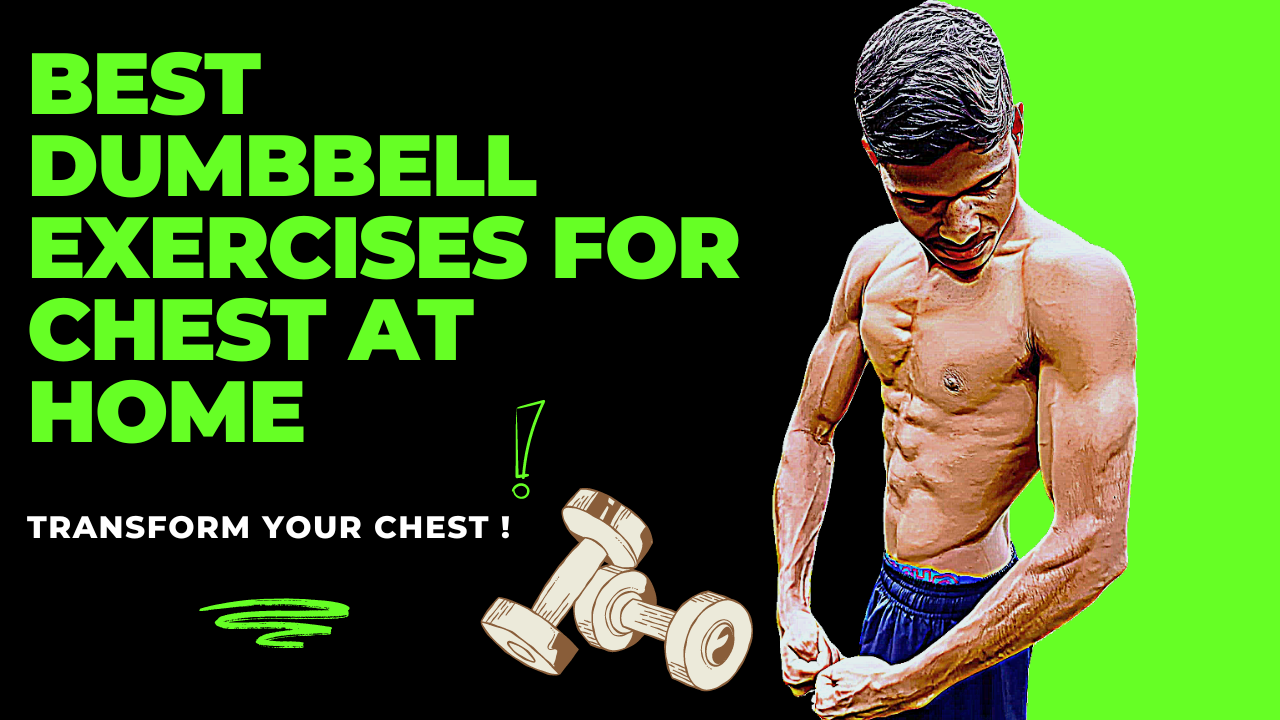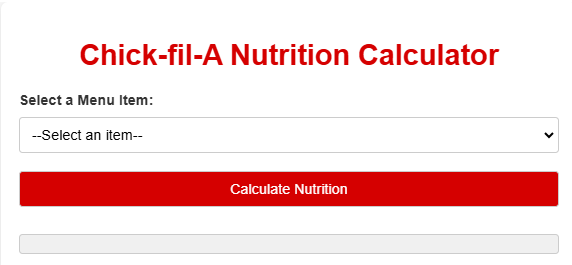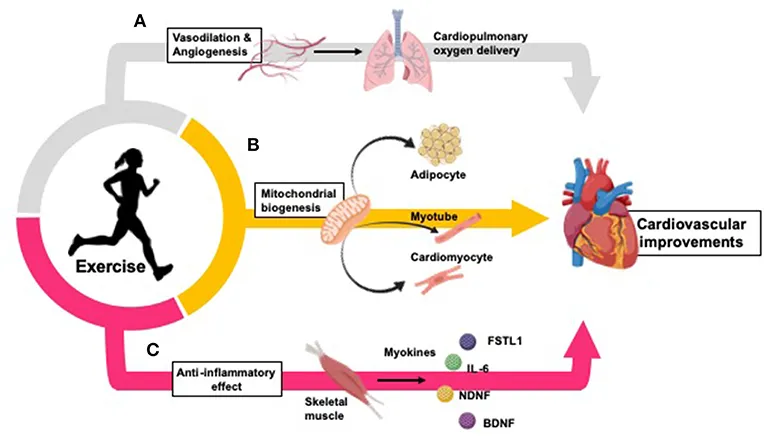Dumbbell Exercises For Chest:
Table of Contents
Are you looking to build a powerful chest with simple equipment? Dumbbells might be your best bet. Not only do they offer a great range of motion, but they also promote balanced muscle development and improved stability. Let’s dive into the best dumbbell chest workouts to help you achieve your fitness goals.
Benefits of Dumbbell Chest Workouts
Increased Range of Motion
Dumbbells allow for a greater range of motion compared to barbells, engaging more muscle fibers and enhancing flexibility.
Balanced Muscle Development
By using dumbbells, you can prevent muscle imbalances since each side of your body works independently, promoting equal strength and muscle growth.
Improved Stability and Coordination
Dumbbell exercises require more stabilization, which helps improve coordination and engage supporting muscles.
Versatility and Accessibility
Dumbbells are versatile and can be used in various settings, from gyms to home workouts, making them accessible to everyone.
Safety Tips for Dumbbell Chest Workouts
Warm-Up and Stretching
Always start with a warm-up to increase blood flow to your muscles and reduce the risk of injury. Stretching the chest, shoulders, and triceps is crucial.
Proper Form and Technique
Maintaining proper form ensures you target the right muscles and prevents injuries. Focus on controlled movements and avoid using momentum.
Appropriate Weight Selection
Choose a weight that challenges you but allows you to complete your sets with proper form. It’s better to start lighter and gradually increase the weight.
Cooling Down and Recovery
After your workout, cool down with light stretching and stay hydrated. This aids in muscle recovery and reduces soreness.
WHAT ARE THE BEST CHEST EXERCISES WITH DUMBBELLS?
- Dumbbell Bench Press: 3 to 4 sets of 6 to 10 repetitions.
- Dumbbell Push-up: 2 to 3 sets of as many repetitions as you can perform
- Incline Dumbbell Press: 2 to 4 sets of 6 to 10 repetitions.
- Dumbbell Fly: 2 to 4 sets of 10 to 15 repetitions.
- Crush Grip Dumbbell Press: 2 to 4 sets of 10 to 15 repetitions.
- 15-Degree Decline Dumbbell Press: 2-4 sets of 8-12 repetitions
- Dumbbell Pullover: 2-4 sets of 10-20 repetitions.
1. Dumbbell Bench Press
Much like the barbell bench press, a dumbbell bench press is great for improving pressing strength and driving growth of the chest muscles. The movement itself and the required range of motion are very similar to that of a barbell bench press, meaning that when we perform dumbbell bench presses, we train the same muscles, though with a bet less stability comparatively.

Programming: 3 to 4 sets of 6 to 10 repetitions.
Weight: Use a weight that leaves you 2 to 3 reps short of failure, e.g., RPE 7 to 8.
To perform a dumbbell bench press:
- Pick up the dumbbells with your hands facing in and with a neutral grip.
- Sit on the bench with the dumbbells’ ends on your legs, inside your hip crease. Lay back and hold the weights on your chest.
- Once you’re ready, take a deep breath, and then press the dumbbells to lock out at the top. Lower the dumbbells slowly and with control until the dumbbells touch your chest.
- Push the dumbbells back up to the beginning position while contracting your chest.
2. Dumbbell Push-Up
It might seem unnecessary to use dumbbells for a simple bodyweight exercise. However, using the dumbbells to create a deficit allows for greater range of motion, thereby creating a more challenging version of the standard push-up. Think of this variation as a poor man’s parallette push-up, an excellent bodyweight choice for training the whole chest area.

Movement Category: Tertiary
Programming: 2 to 3 sets of as many repetitions as you can perform to 1 to2 reps short of failure, e.g., RPE 8 to 9.
Weight: Bodyweight
To do a dumbbell push-up:
- Place two dumbbells on the floor, positioned at a shoulder-width distance apart.
- Start off by grabbing the dumbbells with your body in a push-up or tabletop position. You should be on your toes.
- Holding onto the dumbbells with a neutral grip, keep your core tight and your back straight similar to a normal plank position. This is your starting position
- Initiate the movement down by slightly rocking forward at the shoulder and bending your elbows, lowering your body slowly until your shoulders touch the top of the dumbbells.
- Push yourself up until your arms are fully straightened out. Make sure your back is straight, and your core is tight throughout the movement.
- Repeat the movement for the designated number of reps.
3. Incline Dumbbell Press
The angle of the bench press gets a lot of attention when it comes to discussing both muscle growth and strength development. Many studies have investigated the electrical activity, e.g., “excitation” of muscles like the anterior deltoid, pec major and other muscles during flat, incline, and decline bench press using surface electromyography (sEMG) with varying results. In general, the more vertical the angle of the bench is, the more anterior deltoid and upper pec are being loaded. The lower the angle of the bench, the less anterior deltoid and more pec are being used.
While sEMG differences using different bench angles don’t reliably predict actual outcomes, e.g., differences in muscle size and strength, the incline bench press using a barbell or dumbbells are both great exercises to train the chest. We recommend that you set your bench inclination to anywhere between 15 to 30 degrees.
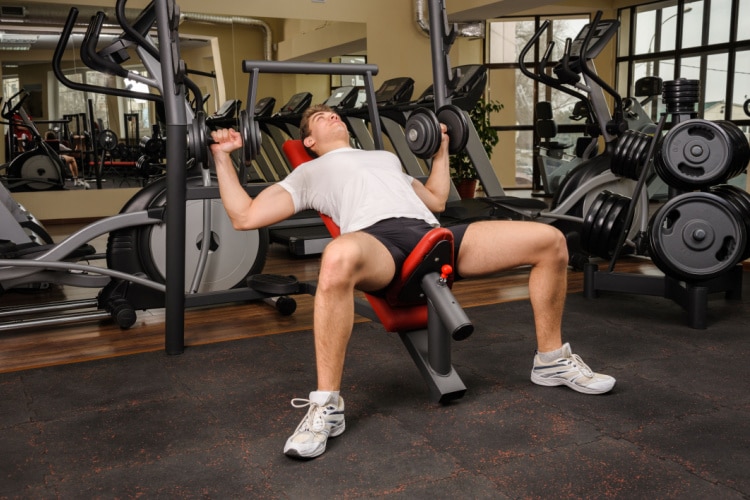
Movement Category: Secondary
Programming: 2 to 4 sets of 6 to 10 repetitions.
Weight: Use a weight that leaves you 2 to 3 reps short of failure, e.g., RPE 7 to 8.
To do an incline dumbbell press:
- Set the bench angle to anywhere between 15 to 30 degrees relative to the horizontal.
- Pick up the dumbbells and lie down on the bench. Your hands should be facing inwards and holding the dumbbells in a neutral grip. Lie down on the bench with the dumbbells in your hands.
- Using your legs for assistance, lift the dumbbells up to your chest. This is the bottom of the range of motion.
- In a smooth motion, press the dumbbells upwards off the chest until your elbows are fully extended.
- Lower the dumbbells back down to the starting position. Do the movement with as much control as possible.
4. Dumbbell Flyes
Dumbbell flyes are a killer chest-focused isolation exercise that will have you feeling the burn in the middle and inner chest area. This is a great finishing exercise to improve hypertrophy in the chest, which can be done on a flat or incline bench based on your preferences.
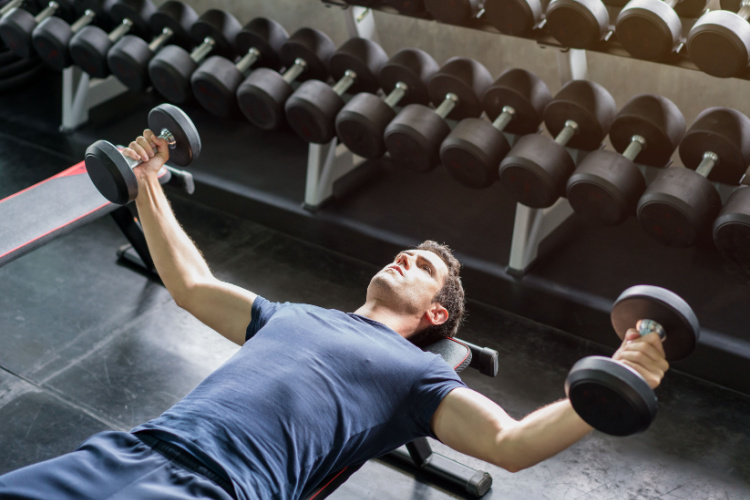
Movement Category: Tertiary
Programming: 2 to 4 sets of 10 to 15 repetitions.
Weight: Use a weight that leaves you 1 to 2 reps short of failure, e.g., RPE 8 to 9.
To do a dumbbell fly:
- Pick up a pair of dumbbells and sit on a flat or incline bench, placing the dumbbells on your thighs.
- Lie on your back on a flat or incline bench, placing your feet on the ground on either side. Using your legs for assistance, move the dumbbells to your chest and press them straight up, extending the elbows to a softly locked position.
- Make sure your palms and dumbbells face one another and that there’s a bit of a bend at your elbow. Keep your head and back pressed onto the bench during the entire activity.
- Under control, slowly lower the dumbbells out to your sides in an arc motion until they’re aligned with your chest. Your elbows shouldn’t bend or extend during the movement and your arms should end up about level with your chest and shoulders.
- Think about pulling the dumbbells “up” and “back together” to reverse the motion. The dumbbells should be directly above the shoulder joint at the top.
5. Crush Grip Dumbbell Press
As the name suggests, you’ll have to crush your pecs to execute a crush grip dumbbell press. It is an isometric exercise that mainly works the pecs, but also activates other muscles, such as the anterior deltoid, lateral deltoids, and triceps.
While going through this exercise, you won’t only have to deal with the resistance of the dumbbell load. There will also be the added resistance of pushing the dumbbells together at the top of your lift, making them a dumbbell press variation, which is particularly great for the triceps and inner chest area.
Ideally, you would do this exercise with hexagonal dumbbells that touch one another during the movement. If you don’t have access to a pair of hexagonal dumbbells, you could always use regular dumbbells that you press together.
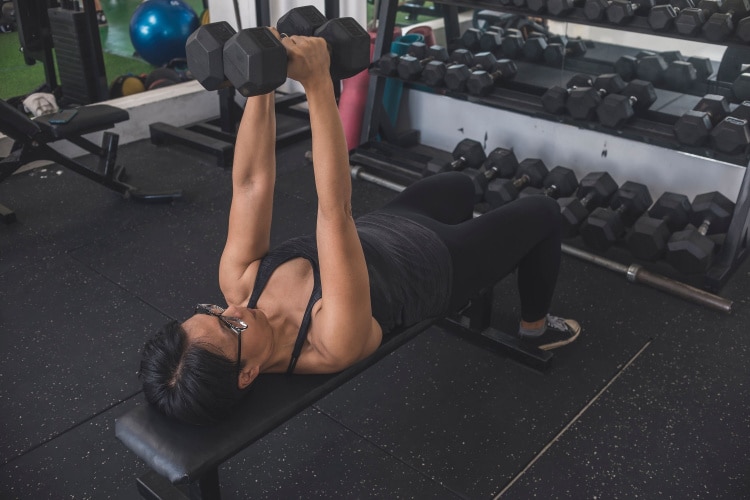
Movement Category: Tertiary
Programming: 2 to 4 sets of 10 to 15 repetitions.
Weight: Use a weight that leaves you 1 to 2 reps short of failure, e.g., RPE 8 to 9.
To do a crush grip dumbbell press:
- Sit on the end of a bench with a dumbbell in each hand.
- Roll back to lie down with control.
- Extend your arms as you lie back with both feet planted firmly on the ground.
- Hold up the dumbbells at an arm’s length away from your shoulders. Your palms should be facing one another and the sides of the dumbbells should be touching. This is your starting position.
- Engage your core, push the dumbbells together, and lower them down to your abdomen. Tuck your arms in slightly as you lower the weights.
- When the dumbbells touch your chest, start raising your arms back up to the starting position. Make sure the dumbbells are pressed together throughout the range of motion.
6. 15-Degree Decline Dumbbell Press
Similar to our discussion regarding the incline dumbbell bench press potentially training the anterior deltoid and upper pec “more” than a more horizontal bench variation, the decline dumbbell bench is likely to predominantly load the pectoralis major and its lower part. Whether this produces regional differences in hypertrophy compared to using a flat or incline bench is unknown, but we think training a muscle group at multiple angles is a good idea for overall development.
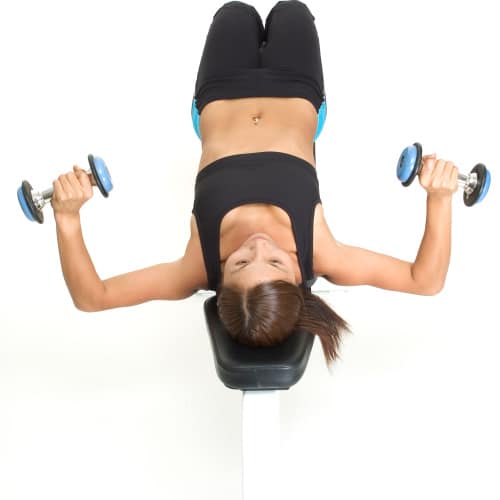
Movement Category: Tertiary
Programming: 2-4 sets of 8-12 repetitions
Weight: Use a weight that leaves you 2 to 3 reps short of failure, e.g. RPE 7 to 8.
To do a 15-degree decline dumbbell press:
- Set the bench incline to -15 degrees relative to the floor.
- Pick up the dumbbells and lie down on the bench. Your hands should be facing inwards and holding the dumbbells in a neutral grip. Lie down on the bench with the dumbbells in your hands. Most decline benches have a split pad to secure your legs against. Make sure you’re secure on the bench.
- Move the dumbbells back and down to touch your chest.. This is the bottom of the range of motion.
- In a smooth motion, press the dumbbells upwards off the chest until your elbows are fully extended.
- Lower the dumbbells back down to the starting position. Do the movement with as much control as possible.
7. Dumbbell Pullover
The dumbbell pullover isn’t just a great exercise for your lower pectorals, but also for the lower part of your upper body in general, hitting the latissimus dorsi and serratus anterior muscles as well. When executed appropriately, with the right amount of control, this exercise can truly fire up your chest.
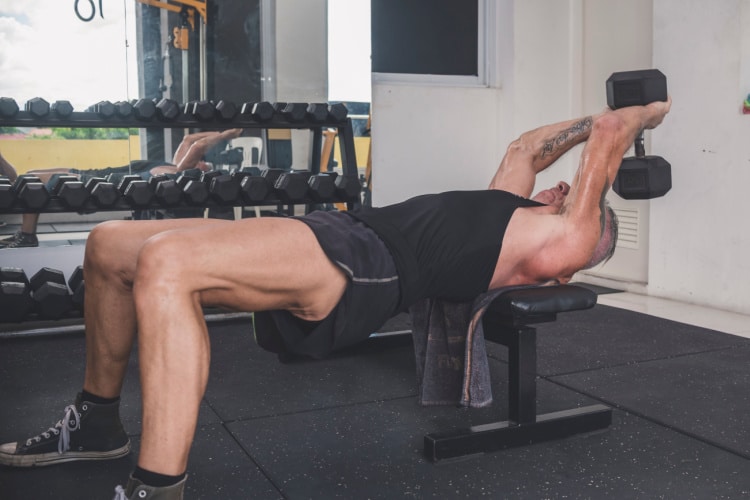
Movement Category: Tertiary
Programming: 2-4 sets of 10-20 repetitions
Weight: Use a weight that leaves you 1 to 2 reps short of failure, e.g. RPE 8 to 9.
To do a dumbbell pullover:
Also Read :
- Also Read :
- Best Weight Loss Apps (2024): 10 Options That Made The Cut After Extensive Testing
- what are the advantages of having a healthy population
- Best Fitness Affiliate Programs
- Summer Healthy Dinner Ideas
- Lie down on the bench with a slight arch in your back.
- Keep your feet flat on the ground and your knees bent at 90 degrees to ensure for stability
- Hold a single dumbbell with both hands, press the dumbbell up over the center of your chest. This is your starting position.
- Maintaining a slight bend at your elbow, lower the dumbbell back over your head in an arcing motion.
- Aim to get the dumbbell as close to the ground as possible. You should feel a deep stretch in your pecs and lats.
- Return to the starting position.
So, now that we’ve covered our favorite dumbbell chest exercises, let’s get into how you can combine them to tailor the best chest workout for you. Keep in mind that different individuals will have different needs according to their fitness level, lifting experience, and training goals. While expectations and needs could vary greatly from trainee to trainee, today, we’ll focus on three main groups of lifters — specifically beginners, those focused on strength, and those focused on hypertrophy, proposing a suitable chest workout for each.
Incorporating Dumbbell Chest Workouts into Your Routine
Frequency and Volume
Aim to train your chest 1-2 times a week, with 3-4 sets of each exercise and 8-12 reps per set for optimal growth.
Combining with Other Exercises
Include dumbbell chest workouts in a balanced routine with other muscle groups to ensure comprehensive development.
Progress Tracking and Adjustments
Keep track of your weights and reps to monitor progress and make adjustments as needed to continue challenging your muscles.
Common Questions and Misconceptions
Do Dumbbell Workouts Build Mass?
Absolutely! Dumbbell workouts can build significant muscle mass with proper diet and progressive overload.
Can Beginners Use Dumbbells for Chest Workouts?
Yes, beginners can start with lighter weights and focus on mastering form before gradually increasing the weight.
What if I Don’t Have a Bench?
You can perform many chest exercises on the floor, such as floor presses and flyes, or use a stability ball as an alternative.
Conclusion
Dumbbell chest workouts are a fantastic way to build a strong, defined chest. They offer numerous benefits, including improved range of motion, balanced muscle development, and versatility. By incorporating these exercises into your routine, you’ll be well on your way to achieving your fitness goals.
How long should a dumbbell chest workout last?
Typically, a dumbbell chest workout should last between 45 minutes to an hour, depending on the number of exercises and sets performed.
Can dumbbell chest workouts replace barbell exercises?
While dumbbell exercises are effective, it’s beneficial to incorporate both dumbbell and barbell exercises for a well-rounded chest workout.
What is the ideal weight for dumbbell chest exercises?
The ideal weight varies per individual. Start with a weight that allows you to perform 8-12 reps with good form, and adjust as you gain strength.
How can I avoid shoulder pain during chest workouts?
Ensure proper warm-up, maintain good form, and avoid overloading the weights. If pain persists, consult a fitness professional.

